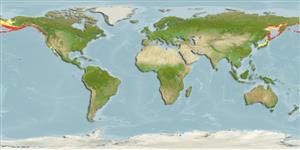Preferred temperature (Ref.
115969): 1.1 - 8.3, mean 3.3 (based on 192 cells).
Phylogenetic diversity index (Ref.
82804): PD
50 = 0.5000 [Uniqueness, from 0.5 = low to 2.0 = high].
Bayesian length-weight: a=0.01413 (0.00731 - 0.02730), b=3.10 (2.94 - 3.26), in cm Total Length, based on LWR estimates for this species & Genus-body shape (Ref.
93245).
Trophic level (Ref.
69278): 3.7 ±0.2 se; based on diet studies.
लौटाव (Ref.
120179): माध्यम, न्यूनतम जनसंख्या दुगनी होने का समय 1.4 - 4.4 वर्ष। (K=0.27-0.45; tm=2-5; tmax=6).
Prior r = 0.32, 95% CL = 0.21 - 0.48, Based on 8 full stock assessments.
Fishing Vulnerability (Ref.
59153): Moderate to high vulnerability (49 of 100).
Climate Vulnerability (Ref.
125649): High to very high vulnerability (71 of 100).
